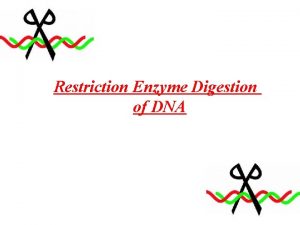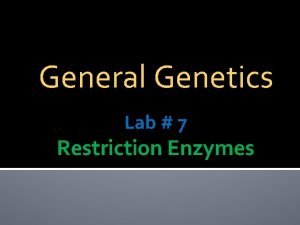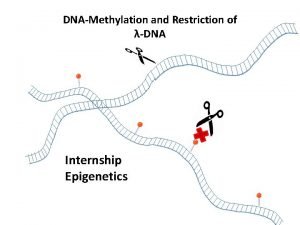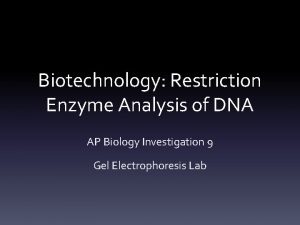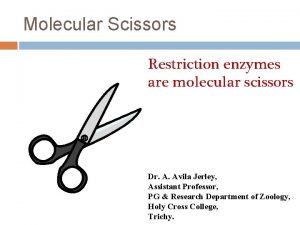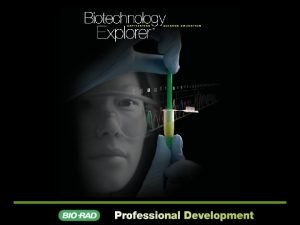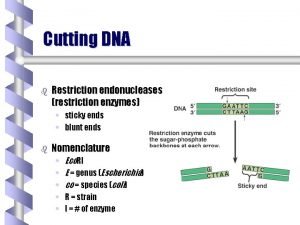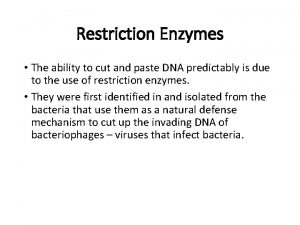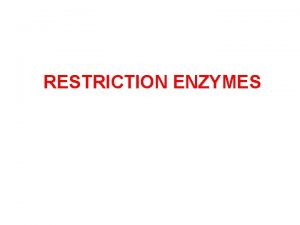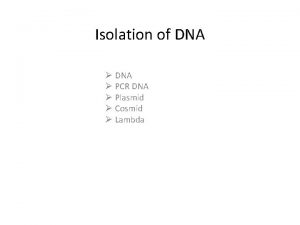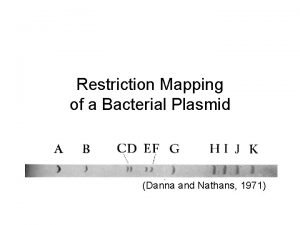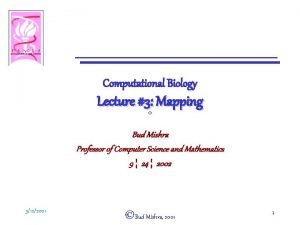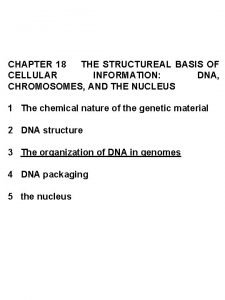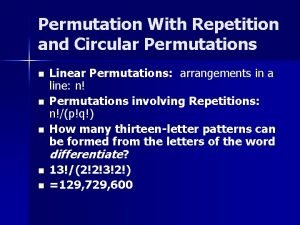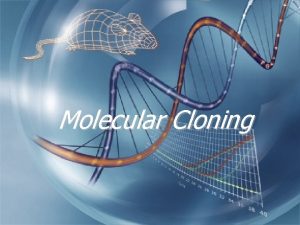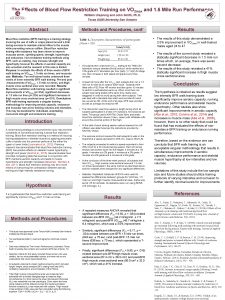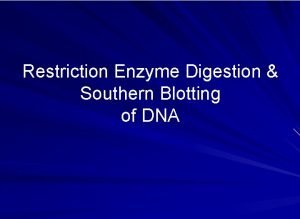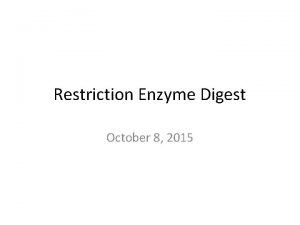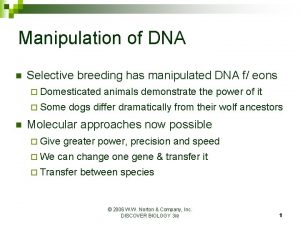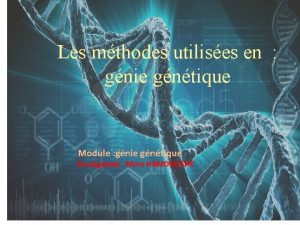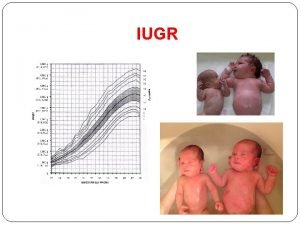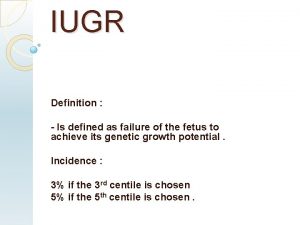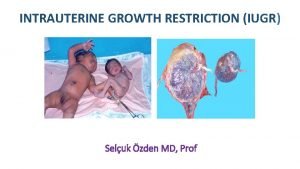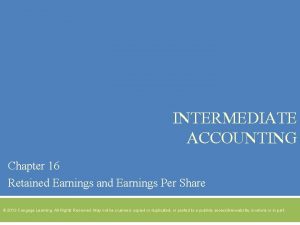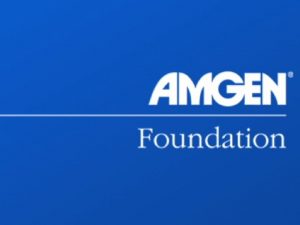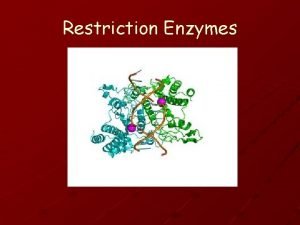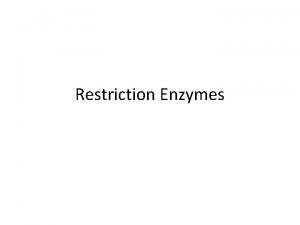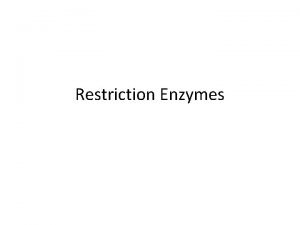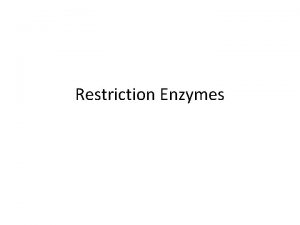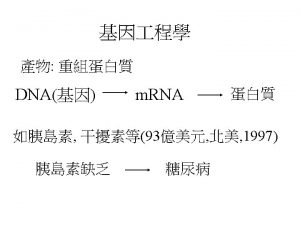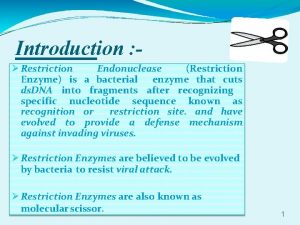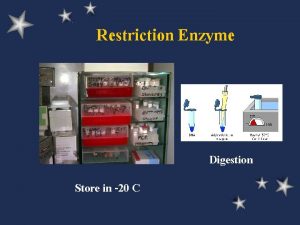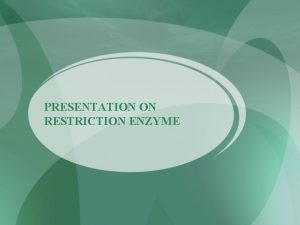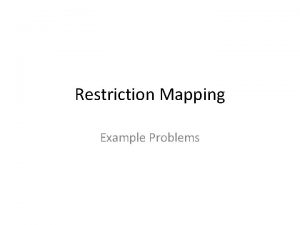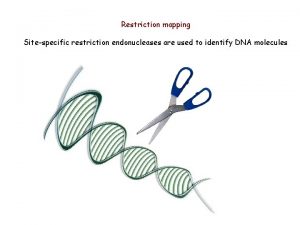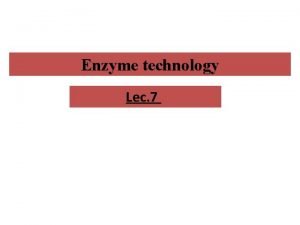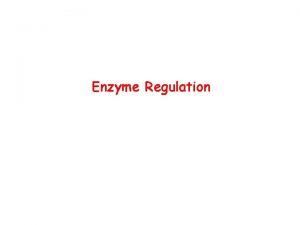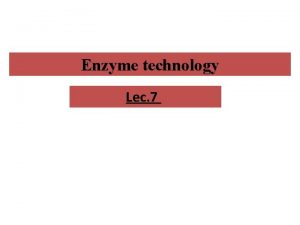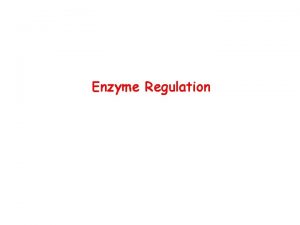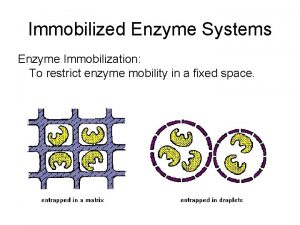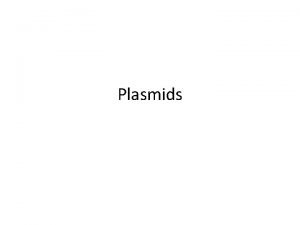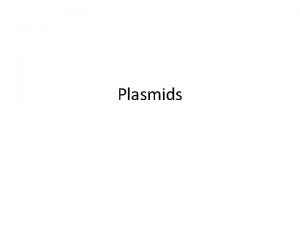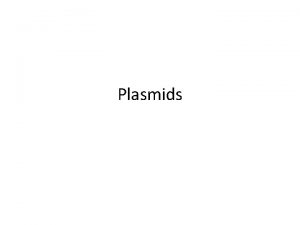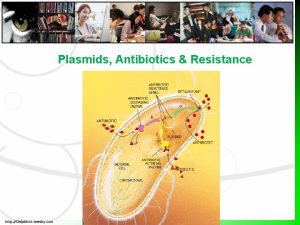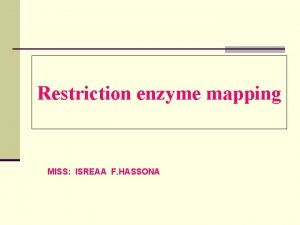Plasmids and Restriction Enzyme Mapping Plasmids Circular nonchromosomal





























- Slides: 29

Plasmids and Restriction Enzyme Mapping

Plasmids • Circular, non-chromosomal pieces of DNA that can replicate in bacteria • Often carry genes encoding resistance to antibiotics (like p. GLO did for ampicillin) • Are cut with restriction enzymes and then can be joined to a piece of DNA from any organism (foreign DNA) that has been cut with the same enzyme

Plasmids • Can be mapped or described in terms of location of restriction sites using simple experiments and logic • Sizes of the resulting DNA fragments are determined and then once can use logic to determine the relative location of the restriction sites • Since plasmids are circular, the number of fragments represents the number of cuts or restriction sites (rubber band)

1000 bp plasmid example Undigested 1000 bp Digested with Enzyme 1 Digested with Enzyme 2 Digested with Enzyme 1 & 2 1000 bp 700 bp 500 bp 300 bp 200 1000 700 300 1000 300 500

Extension Activity 1: Plasmid Mapping • Plasmids and Restriction Enzymes – Read on own • Reading a Plasmid Map Questions – P. 50 -51 1 -8 we will do together as a class – P. 52 -54 1 -12 you will work on in your lab groups – P. 58 -59 1 -4 and 1 -4 new pages that you will work on in your lab groups on Friday and turn in whole packet by end of the hour on Friday

1. From the map of plasmid S 2 list all the restriction enzymes that would cut the plasmid • • • Pvull Eco. R 1 Bam. HI Pstl Hind. III Scal

2. Which plasmid, S 2 or S 5, is the biggest and what is its size? • S 5 is the largest • 9481 bp

3. Using plasmid S 2 as an example, find the restriction sites for the enzyme Pvull. How many sites are there? What is their location? If Pvull was used to cut (digest) this plasmid, how many fragments would it make? • There are 3 sites for Pvull on plasmid S 2 • They are at position 55, 1993, and 3410 • Three fragments would be created if plasmid S 2 was digested with Pvull

4. Next determine the size of the fragments created when S 2 is cut by Pvull. Size is calculated by subtracting the site locations from each other. How big are the fragments from plasmid S 2 that is cut with Pvull? The fragment sizes should add up to the total for that plasmid (5869) base pairs • The fragment sizes are 1417, 1938, and 2514 bp (5869 – 3410 + 55)

5. If the fragments from the plasmid S 2 digested with Pvull were run on an agarose gel, what would they look like? Draw the gel and label the fragments and their sizes ____ 2514 ____ 1938 ____ 1417

6. Now you can determine the fragment sizes of the plasmids when cut with the two enzymes. Eco. R 1 and Pstl. Indicate the sizes of the fragments that would be generate if the plasmid were a digest by Pstl alone, Eco. R 1 alone or by both Pstl and Eco. R 1. Enzyme Eco. R 1 Fragments 5869 Total 5869 Enzymes Pstl Fragments Enzymes Total Fragments Total 2860(5869 -3307 + 298) 1700 (1998 -298) 1159 (3307 -2148) 150 (2148 -1998) Both 5869 Eco. R 1 & Pstl 2817 (5869 -3307 + 255) 1700 (1998 -298) 1159 (3307 -2148) 150 (2148 -1998) 43 (298 -255) 5869

7. If Plasmid S 2 was digested and run on an agarose gel, what would the gel look like? Draw a gel and the fragment sizes if digested by Eco. R 1 alone, Pstl alone, and by Eco. R 1 and Pstl together. 5869

8. How does your diagram in question #7 compare to what was observed in your gel after the experiment? Indicate a reason to why your data in question #7 might be different from the actual experimental data seen from lesson 2. • They should be similar but the bands at 150 and 43 are too small to be observed on the gel

Mapping the Plasmid Questions #1 How big is plasmid S 5? Add the fragments in each column. The total should add up to the size of the plasmid. Why? • The plasmid is 9481 bp in size. • The fragments are cut from the plasmid and all the pieces together should be equal to the size of the original plasmid.

2. Look at the data from the Eco. R 1 digest of plasmid S 5. How many fragments are there? Did the enzyme cut the plasmid, or did it remain as a circle? How could you tell? • There should only be 1 fragment • A first glance, it is not possible to tell if the plasmid was cut although sometimes a circular plasmid does not run through an agarose gel at the same place as a linear piece of DNA of the same size

#3 compare the data from the Pstl digest of plasmid S 5 with that of the Eco. R 1 digest. How many fragments are there? How many restriction sites are there for Pstl? • There should be 7 fragments and therefore 7 restriction sites

#4 How many fragments are there when Eco. R 1 and Pstl are used to digest plasmid S 5? Does that answer the question of whether or not Eco. R 1 cut the plasmid? Why? • There should be 8 fragments when the plasmid is cut by both enzymes. • The additional fragment of Pstl digested plasmid S 5 was shortened by an Eco. R 1 cut?

#5 Which fragment of Pstl digested plasmid S 5 was shortened by an Eco. R 1 cut? • The 2860 bp fragment was cut into 2 fragments (2817 bp and 43 bp)

#6 Draw the Pstl fragment that is cut with Eco. R 1 in plasmid S 5 to demonstrate how the fragment was cut with Eco. R 1.

#7 Restriction mapping is an exercise in critical thinking and logic. Plasmid S 5 is difficult to completely map because of the numerous Pstl restriction sites. With the data, it would be very difficult to place all the restriction sites in order. It is easier to map plasmid S 3. How many times did Eco. R 1 cut plasmid S 3? What are the fragment sizes? • Eco. R 1 cut plasmid S 3 twice. • The fragments are 863 and 6505 bp in size

#8 The data from the Eco. R 1 digest of plasmid S 3 indicate that the fragments are not equal. Draw a possible map and label the Eco. R 1 sites and the sizes of the fragments.

#9. Now draw an approximate map of the Pstl sites on plasmid S 3 and label the Pstl sites and the sizes of the fragments.

#10. Draw a circular map of plasmid S 3 digested with both Pstl and Eco. R 1? Mark sizes of each fragment and name the restriction sites on your figure.

#11. Is there another possible order of restriction sites on plasmid S 3 digested with both Pstl and Eco. R 1? How might you resolve these possibilities? • Using the data from the double digest there are 2 possibilities. However the single digest with Pstl would have fragments of 3687 and 3637 bp (not 4507 and 2860 as was seen).

#12 When the gels were run for this experiment, there were only 3 bands for plasmid S 3. Which band is missing from your gel? Why? • The 43 bp band is so small that it does not bind enough stain to be visible or it may have run off the gel

Extension Activity 2: Constructing a Plasmid Questions #1. Where is the Pstl site on the p. TZ 18 U plasmid? • Position 298

#2 Look at plasmid S 4. What segment of the lambda bacteriophage has been inserted? • Lambda fragment 5, 218 -9, 617 was added

#3 After looking at the plasmid map and also the lambda phage map, can you determine how many Pstl restriction sites were added to the plasmid because of the inserted lambda phage DNA fragment? • Two restriction sites for Pstl were added: site 766 and site 3, 604

#4 Look at plasmid S 1. What segment of lambda was added to that plasmid? Were any Pstl restriction sites added to the plasmid with the inserted fragment of lambda DNA? • Lambda fragment 20, 285 – 22, 425 was added to plasmid S 1. No additional Pstl sites were added.
 Enzyme
Enzyme Restriction enzymes
Restriction enzymes Cla 1 restriction enzyme
Cla 1 restriction enzyme Restriction enzyme analysis of dna ap bio lab
Restriction enzyme analysis of dna ap bio lab Molecular scissors
Molecular scissors Restriction enzyme
Restriction enzyme Restriction enzyme
Restriction enzyme Copy and paste
Copy and paste Application of restriction enzymes
Application of restriction enzymes Mini prep
Mini prep Restriction example
Restriction example Restriction mapping
Restriction mapping Restriction mapping
Restriction mapping Circular permutation with repetition
Circular permutation with repetition The associative mapping is costlier than direct mapping.
The associative mapping is costlier than direct mapping. Forward mapping vs backward mapping
Forward mapping vs backward mapping Transform mapping dan transaction mapping
Transform mapping dan transaction mapping Horizontal lines in hair
Horizontal lines in hair Illustration of the steps in restriction digestion and pcr
Illustration of the steps in restriction digestion and pcr Restriction ends
Restriction ends Blood flow restriction protocol
Blood flow restriction protocol Southern blotting animation
Southern blotting animation Palindromic sequence
Palindromic sequence Dean pomerleau
Dean pomerleau Restriction enzymes gel electrophoresis
Restriction enzymes gel electrophoresis Carte de restriction linéaire
Carte de restriction linéaire Asymmetrical intrauterine growth restriction
Asymmetrical intrauterine growth restriction Symmetrical growth restriction
Symmetrical growth restriction What causes iugr
What causes iugr A restriction/appropriation of retained earnings
A restriction/appropriation of retained earnings
